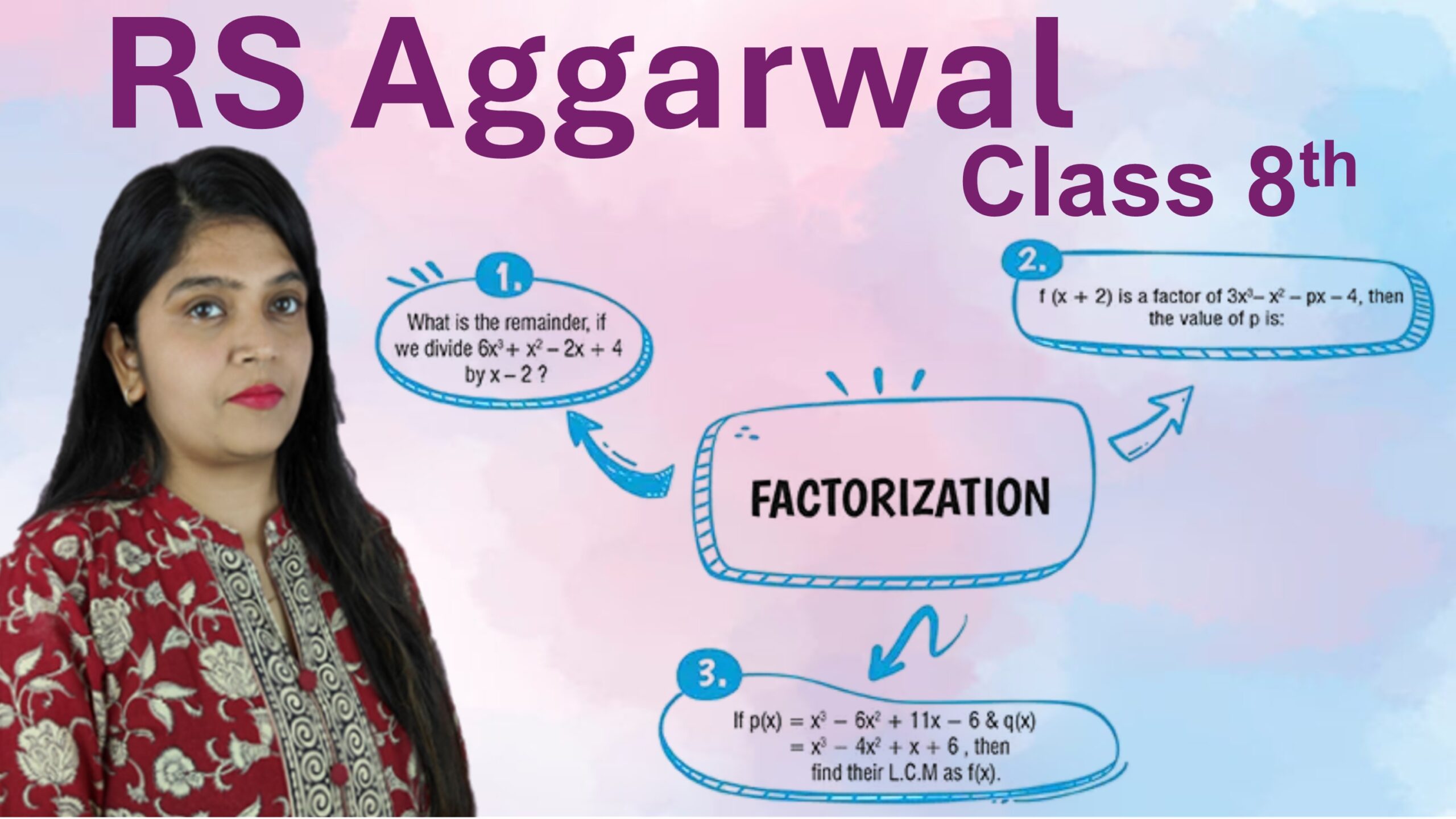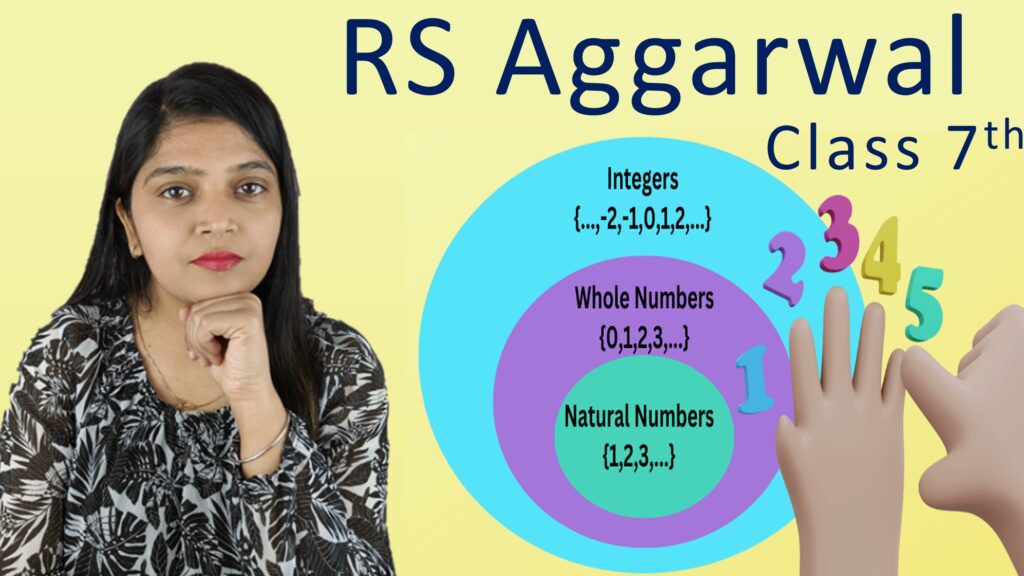Exercise: 14-B
Q1: 5xy + 20x − 9y − 36
Step 1: Group the terms in pairs:
= (5xy + 20x) − (9y + 36)
Step 2: Take out common factor from each group:
= 5x(y + 4) − 9(y + 4)
Step 3: Now (y + 4) is common.
= (y + 4)(5x − 9)
Step 4 (Verification): Expand to check:
(y + 4)(5x − 9) = 5xy + 20x − 9y − 36 ✔️
Answer: (y + 4)(5x − 9)
Q2: 5ab − 10b − 7a + 14
Step 1: Group the terms in pairs:
= (5ab − 10b) − (7a − 14)
Step 2: Take out common factor from each group:
= 5b(a − 2) − 7(a − 2)
Step 3: Now (a − 2) is common.
= (a − 2)(5b − 7)
Step 4 (Verification): Expand to check:
(a − 2)(5b − 7) = 5ab − 10b − 7a + 14 ✔️
Answer: (a − 2)(5b − 7)
Q3: 9xy + 7y − 9y² − 7x
Step 1: Group the terms in pairs:
= (9xy − 9y²) + (7y − 7x)
Step 2: Take out common factor from each group:
= 9y(x − y) − 7(x − y)
Step 3: Now (x − y) is common.
= (x − y)(9y − 7)
Step 4 (Verification): Expand to check:
(x − y)(9y − 7) = 9xy + 7y − 9y² − 7x ✔️
Answer: (x − y)(9y − 7)
Q4: 3ax − 6ay − 8by + 4bx
Step 1: Group the terms in pairs:
= (3ax − 6ay) + (4bx − 8by)
Step 2: Take out common factor from each group:
= 3a(x − 2y) + 4b(x − 2y)
Step 3: Now (x − 2y) is common.
= (x − 2y)(3a + 4b)
Step 4 (Verification): Expand to check:
(x − 2y)(3a + 4b) = 3ax − 6ay + 4bx − 8by ✔️
Answer: (x − 2y)(3a + 4b)
Q5: 4x² − 10xy − 6xz + 15yz
Step 1: Group the terms in pairs:
= (4x² − 10xy) − (6xz − 15yz)
Step 2: Take out common factor from each group:
= 2x(2x − 5y) − 3z(2x − 5y)
Step 3: Now (2x − 5y) is common.
= (2x − 5y)(2x − 3z)
Step 4 (Verification): Expand to check:
(2x − 5y)(2x − 3z) = 4x² − 6xz − 10xy + 15yz ✔️
Answer: (2x − 5y)(2x − 3z)
Q6: 3ab − 6bc − 3ax + 6cx
Step 1: Group the terms in pairs:
= (3ab − 3ax) − (6bc − 6cx)
Step 2: Take out common factor from each group:
= 3a(b − x) − 6c(b − x)
Step 3: Now (b − x) is common.
= (b − x)(3a − 6c)
Step 4: Simplify further:
= (b − x)·3(a − 2c)
Step 5 (Verification): Expand to check:
3(b − x)(a − 2c) = 3ab − 6bc − 3ax + 6cx ✔️
Answer: 3(b − x)(a − 2c)
Q7: a² + ab(1+b) + b³
Step 1: Expand the middle term:
= a² + ab + ab² + b³
Step 2: Group the terms in pairs:
= (a² + ab) + (ab² + b³)
Step 3: Take out common factor from each group:
= a(a + b) + b²(a + b)
Step 4: Now (a + b) is common.
= (a + b)(a + b²)
Step 5 (Verification): Expand to check:
(a + b)(a + b²) = a² + ab² + ab + b³ ✔️
Answer: (a + b)(a + b²)
Q8: xy² + (x−1)y − 1
Step 1: Expand the middle term:
= xy² + xy − y − 1
Step 2: Group the terms in pairs:
= (xy² + xy) − (y + 1)
Step 3: Take out common factor from each group:
= x·y(y + 1) − 1(y + 1)
Step 4: Now (y + 1) is common.
= (y + 1)(xy − 1)
Step 5 (Verification): Expand to check:
(y + 1)(xy − 1) = xy² + xy − y − 1 ✔️
Answer: (y + 1)(xy − 1)
Q9: b² − ab(1 − a) − a³
Step 1: Expand the middle term:
−ab(1 − a) = −ab + a²b
Step 2: Substitute to get a four-term expression:
= b² − ab + a²b − a³
Step 3: Group the terms in pairs:
= (b² − ab) + (a²b − a³)
Step 4: Factor out common factors from each group:
= b(b − a) + a²(b − a)
Step 5: Now (b − a) is common.
= (b − a)(b + a²)
Step 6 (Verification): Expand to check:
(b − a)(b + a²) = b² + a²b − ab − a³ = b² − ab + a²b − a³ ✔️
Answer: (b − a)(b + a²)
Q10: y² − y(2b + a) + 2ab
Step 1: Expand the middle term:
= y² − 2by − ay + 2ab
Step 2: Group the terms in pairs:
= (y² − ay) − (2by − 2ab)
Step 3: Factor out common terms:
= y(y − a) − 2b(y − a)
Step 4: Now (y − a) is common.
= (y − a)(y − 2b)
Step 5 (Verification): Expand to check:
(y − a)(y − 2b) = y² − 2by − ay + 2ab ✔️
Answer: (y − a)(y − 2b)
Q11: x − 2 − (x − 2)² + ax − 2a
Step 1: Expand (x − 2)²:
= x − 2 − (x² − 4x + 4) + ax − 2a
Step 2: Simplify:
= −x² + (a+5)x − (2a+6)
Step 3: This is a quadratic. Factorise using discriminant method.
D = (a+5)² − 4(2a+6) = (a+1)²
Step 4: Roots of the quadratic:
x = (a+3),x = 2
Step 5: So factorised form:
= −(x − (a+3))(x − 2) = (x − 2)(3 + a – x)
Step 6 (Verification): Expand:
(x − 2)(3 + a – x) = −x² + (a+5)x − (2a+6) ✔️
Answer: (x − 2)(3 + a – x)
Q12: x − 1 − (x − 1)² + 4 − 4x
Step 1: Expand (x − 1)²:
= x − 1 − (x² − 2x + 1) + 4 − 4x
Step 2: Simplify:
= −x² − x + 2
Step 3: Factorise:
= −(x² + x − 2)
= −[(x² + 2x) − (x+2)]
= −(x−1)(x+2)
Answer: −(x − 1)(x + 2)
Q13: b(c − d)² − a(d − c) + 5c − 5d
Step 1: Replace (d − c) = −(c − d):
= b(c − d)² + a(c − d) + 5c − 5d
Step 2: Group the terms:
= b(c − d)² + a(c − d) + 5(c − d)
Step 3: Take common factor (c − d):
= (c − d)[b(c − d) + a + 5] = (c − d)(bc − bd + a + 5)
Answer: (c − d)(bc − bd + a + 5)
Q14: ab(c² + d²) − a²cd − b²cd
Step 1: Expand expression clearly:
= ab(c² + d²) − a²cd − b²cd
Step 2: Group the terms:
= (abc² + abd²) − (a²cd + b²cd)
Step 3: Take out common factors:
= ab(c² + d²) − cd(a² + b²)
Step 4: Rearrange in pairs:
= (ac)(bc) + (ad)(bd) − (ac)(ad) − (bc)(bd)
Step 5: Group again:
= (ac)(bc − ad) + (bd)(ad − bc)
= (ac)(bc − ad) − (bd)(bc − ad)
Step 6: Factorise common term (bc − ad):
= (bc − ad)(ac − bd)
Answer: (bc − ad)(ac − bd)
Q15: ab(x² + y²) + xy(a² + b²)
Step 1: Expand expression:
= abx² + aby² + a²xy + b²xy
Step 2: Rearrange terms for grouping:
= (abx² + a²xy) + (aby² + b²xy)
Step 3: Factorise each group:
= ax(bx + ay) + by(ay + bx)
Step 4: Notice common factor (ax + by):
= (ax + by)(bx + ay)
Answer: (ax + by)(bx + ay)
Q16: ab(x² + y²) − xy(a² + b²)
Step 1: Expand expression:
= abx² + aby² − a²xy − b²xy
Step 2: Rearrange terms for grouping:
= (abx² − a²xy) + (aby² − b²xy)
Step 3: Factorise each group:
= ax(bx − ay) − by(bx − ay)
Step 4: Take out the common factor (bx − ay):
= (bx − ay)(ax − by)
Answer: (bx − ay)(ax − by)
Q17: (ax + by)² + (bx − ay)²
Step 1: Expand each square:
(ax + by)² = a²x² + 2abxy + b²y²
(bx − ay)² = b²x² − 2abxy + a²y²
Step 2: Add both expansions:
= (a²x² + 2abxy + b²y²) + (b²x² − 2abxy + a²y²)
= a²x² + b²x² + a²y² + b²y²
Step 3: Group terms by common factor:
= (a² + b²)x² + (a² + b²)y²
Step 4: Take common (a² + b²):
= (a² + b²)(x² + y²)
Answer: (a² + b²)(x² + y²)
Q18: a(a + b − c) − bc
Step 1: Expand the bracket:
a(a + b − c) = a² + ab − ac
Expression = a² + ab − ac − bc
Step 2: Group the terms:
= (a² + ab) − (ac + bc)
Step 3: Take common factors:
= a(a + b) − c(a + b)
Step 4: Take out (a + b):
= (a + b)(a − c)
Answer: (a + b)(a − c)
Q19: a(a − 2b − c) + 2bc
Step 1: Expand the bracket:
a(a − 2b − c) = a² − 2ab − ac
Expression = a² − 2ab − ac + 2bc
Step 2: Group the terms:
= (a² − 2ab) − (ac − 2bc)
Step 3: Take common factors:
= a(a − 2b) − c(a − 2b)
Step 4: Take out (a − 2b):
= (a − 2b)(a − c)
Answer: (a − 2b)(a − c)
Q20: 3x⁵ − 6x⁴ − 2x³ + 4x² + x − 2
Step 1: Group the terms:
= (3x⁵ − 6x⁴) + (−2x³ + 4x²) + (x − 2)
Step 2: Take out common factors:
= 3x⁴(x − 2) − 2x²(x − 2) + 1(x − 2)
Step 3: Take out common (x − 2):
= (x − 2)(3x⁴ − 2x² + 1)
Step 4: Check further factorisation:
Since 3x⁴ − 2x² + 1 has no real factors, we keep it as is.
Answer: (x − 2)(3x⁴ − 2x² + 1)
Q21: 2a + 2b – 3cx – 3bx + 2c – 3ax
Step 1: Group the terms suitably:
\[
= (2a + 2b) + (-3cx – 3bx – 3ax) + (2c)
\]
or better as:
\[
= (2a + 2b) + (-3ax – 3bx – 3cx) + 2c
\]Step 2: Factor common terms in each group:
\[
= 2(a + b) – 3x(a + b + c) + 2c
\]Step 3: Combine the terms involving \(a + b\):
\[
= 2(a + b) – 3x(a + b) – 3xc + 2c \\
= (a + b)(2 – 3x) + c(2 – 3x)
\]Step 4: Factor out the common factor \((2 – 3x)\):
\[
= (2 – 3x)\left[(a + b) + c\right] \\
= (2 – 3x)(a + b + c)
\]Answer: \((2 – 3x)(a + b + c)\)
Q22: a²b² + b² + a² + 1
Step 1: Group the terms:
= (a²b² + b²) + (a² + 1)
Step 2: Take common factors:
= b²(a² + 1) + 1(a² + 1)
Step 3: Factorise further:
= (a² + 1)(b² + 1)
Answer: (a² + 1)(b² + 1)







Leave a Comment